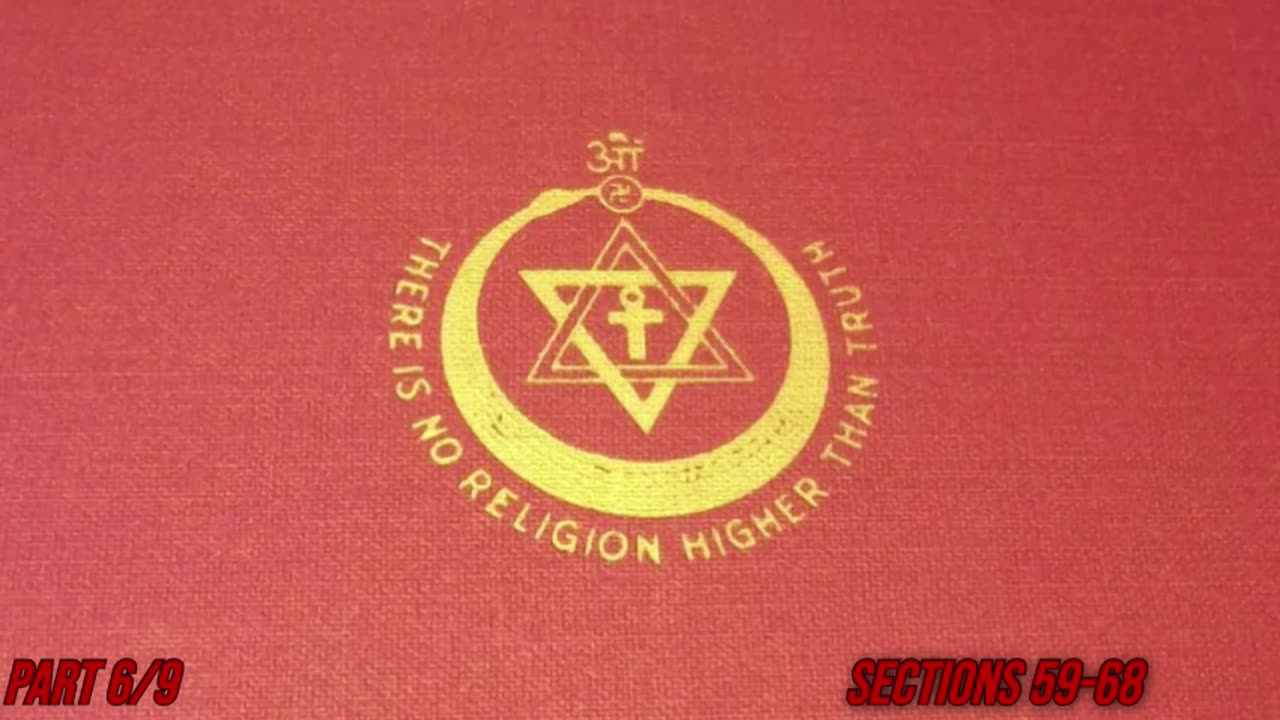Premium Only Content

The Secret Doctrine by Blavatsky Part 6/9 Sections 59-68
Part 6 (Sections 59-68) of "The Secret Doctrine" by Helena Petrovna Blavatsky continues the intricate exploration of esoteric teachings, moving deeper into the mystical aspects of anthropology, the nature of consciousness, and the influence of hidden spiritual laws on humanity’s development. This section integrates occult philosophy with metaphysical ideas, exploring how spiritual evolution and cosmic principles manifest within the individual soul and collective human experience.
Overview of Part 6:
Blavatsky focuses on the inner structure of the human being, discussing how spiritual energies and subtle bodies interact with physical form. She examines the connection between cosmic forces and the human soul, emphasizing that consciousness is not confined to material reality but exists across multiple planes of existence. This part also addresses the role of spiritual initiates and occult knowledge in guiding humanity's evolution, as well as the interplay between individual will and cosmic destiny.
Key Concepts and Sections in Part 6:
1. The Sevenfold Nature of Man:
A key focus in this part is the sevenfold division of the human being, a concept that parallels the sevenfold nature of the cosmos introduced earlier. Blavatsky outlines the seven principles of the human constitution, which include:
Physical Body (Sthula Sharira): The dense material form.
Vitality (Prana or Jiva): The life force or energy.
Astral Body (Linga Sharira): The subtle double that serves as a blueprint for the physical body.
Desire Body (Kama-Rupa): The seat of emotions and desires.
Mind (Manas): Split into Lower Manas (the rational mind) and Higher Manas (the spiritual mind).
Soul (Buddhi): The spiritual soul that connects to universal consciousness.
Spirit (Atma): The highest, unchanging aspect of the self, which is identical with the universal spirit.
Blavatsky emphasizes that understanding these seven principles is crucial for spiritual development, as they represent the different layers of consciousness that an individual must integrate to achieve spiritual enlightenment.
2. Interconnectedness of Microcosm and Macrocosm:
Blavatsky expands on the Law of Correspondence, asserting that man is a microcosm of the macrocosm (the universe). She argues that the same principles that govern cosmic evolution also operate within the individual soul. The sevenfold structure of human beings mirrors the seven cosmic planes, suggesting a unity between human consciousness and the greater universe.
This concept reinforces the idea that self-knowledge leads to an understanding of universal truths, as the inner worlds of thought, emotion, and spirit reflect the larger cosmic order.
3. Karma, Reincarnation, and Spiritual Progress:
Part 6 delves deeper into the law of karma and its role in the cycle of reincarnation. Blavatsky explains that karma is not just a moral law but a universal principle that governs the balance of energy across all planes of existence.
She discusses how individual actions impact spiritual progress, arguing that the karmic effects of thoughts, words, and deeds carry over from one incarnation to the next, shaping the evolution of the soul. This teaching is central to Theosophy’s view of spiritual development, where each lifetime offers opportunities to learn and grow.
The karmic law is presented as a compassionate force, offering justice and opportunities for spiritual refinement. Blavatsky stresses that understanding karma is essential for breaking free from the cycle of rebirth.
4. Role of Spiritual Initiates and Occult Brotherhoods:
This section elaborates on the existence of spiritual initiates and adepts who have mastered occult knowledge and act as guides for humanity. Blavatsky describes a spiritual hierarchy that includes hidden masters or Mahatmas—beings who have transcended ordinary human limitations and possess profound esoteric knowledge.
These Mahatmas are said to belong to occult brotherhoods that have preserved the secret teachings of ancient wisdom across the ages. They work subtly, influencing the course of human evolution through their spiritual guidance and teaching. Blavatsky’s mention of these figures aims to validate Theosophy as a continuation of an ancient esoteric tradition.
This concept links the individual spiritual journey to a larger collective process, suggesting that those who seek spiritual truth are part of a broader movement guided by these higher beings.
5. Spiritual Will and the Power of Thought:
Blavatsky discusses the power of thought and will in shaping both individual reality and spiritual destiny. She teaches that consciousness is not confined to the physical brain but is a universal force that can influence subtle realms.
The human mind has the potential to access higher planes of consciousness through meditation, concentration, and esoteric practices. Blavatsky emphasizes the importance of spiritual discipline and self-mastery for those who wish to transcend the limitations of material existence and achieve higher states of awareness.
This theme aligns with Hermetic and Rosicrucian teachings on the creative power of the mind, suggesting that the inner transformation of the individual is reflected in the outer world.
6. Astral Realms and Spiritual Perception:
In Part 6, Blavatsky introduces the concept of astral realms—subtle worlds that exist beyond physical perception. She claims that these astral planes are inhabited by spiritual beings, ranging from devas and angels to elementals and lower astral entities.
The astral body (Linga Sharira) is the vehicle through which humans can interact with these realms during dreams, trance states, and spiritual practices. Blavatsky emphasizes that clairvoyance and other psychic abilities are natural extensions of spiritual development, but warns of the dangers of misusing these powers without proper ethical guidance.
The astral realm is portrayed as a mirror of the physical world, where thoughts and desires take form. Blavatsky warns that one must cultivate spiritual purity to navigate these subtle dimensions without falling prey to illusion.
Purpose of Part 6:
Part 6 aims to deepen the reader’s understanding of the mystical relationship between the human soul and the universe, offering insights into how spiritual principles manifest within the individual and shape cosmic evolution.
Blavatsky’s teachings here are intended to empower seekers of spiritual truth by revealing the hidden potential within consciousness and encouraging inner transformation as a means of connecting to higher realities.
Style and Presentation:
Blavatsky’s writing in this part combines mystical teachings with philosophical discourse, aiming to offer a comprehensive view of occult anthropology and spiritual psychology. Her approach remains symbolic and metaphysical, presenting esoteric ideas in a style that demands contemplation and intuitive understanding.
The presentation blends theosophical concepts with references to ancient scriptures, Eastern philosophy, and Hermetic traditions, aiming to create a synthesis of spiritual knowledge.
Significance of Part 6:
Part 6 is significant for its exploration of the internal dimensions of human existence, emphasizing that the inner journey is a reflection of cosmic evolution. It provides a framework for understanding how spiritual principles influence physical life and how individual transformation is intertwined with the greater destiny of humanity.
This section is especially relevant to those interested in esoteric psychology and the development of consciousness, as it outlines a path of self-mastery that aligns with theosophical ideals.
ABOUT THE AUTHOR:
Helena Petrovna Blavatsky (1831-1891)
Helena Petrovna Blavatsky—often known simply as Madame Blavatsky or HPB—was a Russian occultist, mystic, and co-founder of the Theosophical Society, a movement that sought to reconcile spirituality with science and philosophy by drawing upon ancient esoteric traditions. Born on August 12, 1831, in Ekaterinoslav, then part of the Russian Empire (now Dnipro, Ukraine), she is widely considered one of the most influential figures in the modern esoteric and occult revival of the late 19th century. Her writings and teachings, particularly "Isis Unveiled" (1877) and "The Secret Doctrine" (1888), continue to shape New Age thought, Western esotericism, and spiritual movements to this day.
Early Life and Influences
Blavatsky was born into a noble Russian family, with her mother, Helena Andreyevna von Hahn, being a novelist and her father, Colonel Peter Hahn, serving in the Russian military. From a young age, she displayed an interest in the mystical and supernatural, with accounts of her life mentioning experiences with clairvoyance, telepathy, and astral travel. Her family's access to Western literature and philosophy exposed her to esoteric ideas early on, which she later developed into her own theosophical framework.
In her early adulthood, Blavatsky embarked on extensive travels that took her across Europe, the Middle East, India, and Tibet. During these journeys, she claimed to have studied with esoteric teachers and initiates, particularly in India and Tibet, who taught her the ancient wisdom traditions that would form the core of her later teachings.
Founding of the Theosophical Society
In 1875, Blavatsky co-founded the Theosophical Society in New York City with Henry Steel Olcott and William Quan Judge. The society aimed to:
1. Promote the study of comparative religion, philosophy, and science.
2. Investigate unexplained laws of nature and the powers latent in humanity.
3. Promote universal brotherhood, transcending distinctions of race, creed, sex, caste, or color.
The Theosophical Society played a pivotal role in introducing Eastern philosophies, such as Hinduism and Buddhism, to the Western world, promoting the idea that all religions contain an underlying spiritual truth. Blavatsky served as the spiritual head of the movement, positioning herself as a messenger for the hidden masters or Mahatmas, whom she claimed were enlightened beings guiding the spiritual evolution of humanity.
Key Works and Esoteric Teachings
"Isis Unveiled" (1877): Blavatsky’s first major work sought to challenge materialism and scientific reductionism, arguing that ancient wisdom held the keys to understanding spiritual phenomena and the hidden aspects of nature. The book covered a wide range of subjects, from mythology to comparative religion, psychic phenomena, and occult sciences.
"The Secret Doctrine" (1888): This two-volume work is considered her magnum opus. It lays out a cosmological vision based on the Stanzas of Dzyan, which she claimed were ancient texts from Tibet. The first volume, "Cosmogenesis", focuses on the origin of the universe and cosmic evolution, while the second volume, "Anthropogenesis", explores the esoteric history of humanity through the seven root races. Blavatsky aimed to provide a synthesis of science, religion, and philosophy, drawing upon Eastern mysticism, Hermeticism, and Kabbalistic traditions.
Affiliations with Secret Societies
Blavatsky’s life and work were deeply intertwined with the esoteric traditions and secret societies that she studied and promoted. While there is some ambiguity surrounding her precise affiliations, her connections to various mystical and occult orders are well-documented:
1. Freemasonry:
Blavatsky claimed connections with Freemasonry, particularly through Co-Freemasonry and esoteric branches of the craft that included women, which was unusual for traditional Freemasonry. She was associated with Rite of Adoption lodges, a branch of Continental Masonry that allowed female members.
Her writings often reflect a Masonic worldview, utilizing symbolism and concepts familiar to Masonic teachings, such as the spiritual significance of geometric shapes and initiatory practices.
2. Rosicrucianism:
Blavatsky’s teachings frequently align with Rosicrucian ideals, emphasizing the existence of a hidden knowledge that dates back to ancient Egypt, Hermeticism, and alchemical traditions. She often spoke of the Rosicrucians as being among the guardians of ancient wisdom.
While no direct records confirm her initiation into a formal Rosicrucian order, Blavatsky’s writings suggest a deep sympathy for Rosicrucian principles, particularly in her emphasis on spiritual alchemy and the transmutation of the soul.
3. Hermetic Brotherhood of Luxor:
Blavatsky’s early writings and teachings have connections to the Hermetic Brotherhood of Luxor, a 19th-century occult order that combined Egyptian mysteries with Western esotericism. Some sources suggest that she had correspondences with members of this brotherhood, sharing a common interest in ancient Egyptian mysticism.
The Hermetic principles she discusses in her writings, such as the Law of Correspondence ("As above, so below"), reflect the influence of Hermetic thought on her theosophical worldview.
4. Kabbalistic Traditions:
Blavatsky’s work is heavily influenced by Jewish Kabbalah, which she viewed as a repository of esoteric wisdom with roots in ancient Chaldean and Egyptian mysticism. She believed that Kabbalistic teachings were closely related to the mysteries of the East, drawing parallels between Kabbalistic concepts and Vedic philosophy.
Although not formally initiated into any Kabbalistic society, Blavatsky incorporated Kabbalistic symbols, such as the Sephiroth and the Tree of Life, into her interpretation of the cosmos and spiritual evolution.
Controversies and Criticisms
Blavatsky’s life and work were marked by significant controversy. She faced criticism and skepticism from the scientific community of her time, as well as from Christian missionaries who opposed her promotion of Eastern religions in the West. Her claims of communication with the Mahatmas were challenged by skeptics, most notably during the Hodgson Report published by the Society for Psychical Research in 1885, which accused her of being a charlatan. However, many of her followers continued to believe in her spiritual authority and the validity of her occult experiences.
Legacy and Impact
Blavatsky’s influence extends far beyond her lifetime, shaping the New Age movement, Western occult traditions, and esoteric schools of thought. Her emphasis on the unity of all religions, the divine nature of the cosmos, and the importance of spiritual evolution has had a profound impact on mystical traditions and philosophical inquiries into the nature of reality. The Theosophical Society she co-founded continues to have branches around the world, promoting the study of esoteric philosophy and spiritual science.
Helena Petrovna Blavatsky remains a polarizing figure—revered by many as a spiritual visionary and pioneer of esoteric thought, while criticized by others as a controversial mystic with unorthodox ideas. Regardless of perspective, her role in reshaping the Western spiritual landscape and bridging Eastern and Western philosophies is undeniable, making her a central figure in the history of modern esotericism.
-
 1:30:58
1:30:58
Deus Meum Que Jus
5 days agoTHE Ancient Arabic Order of the Nobles of the Mystic Shrine FOR NORTH AMERICA
313 -
 46:39
46:39
The Bold Lib
1 day agoOwen Shroyer: BOLDTALK W/Angela Belcamino
5.74K21 -
 7:57
7:57
Blackstone Griddles
1 day agoDouble Barrel Sausage Sandwich | Blackstone Griddles
26.2K1 -
 32:24
32:24
Forrest Galante
12 hours agoHunting and Eating The World's WORST Fish (Everglades At Night)
109K7 -
 32:10
32:10
Nikko Ortiz
17 hours agoSecret Agent Infiltrates Neo-Nazis...
28.3K16 -
 15:04
15:04
MetatronGaming
1 day agoOriginal Commodore 64 VS C64 Maxi - Review and Comparison
31.6K9 -
 9:46
9:46
MattMorseTV
16 hours ago $21.20 earnedTrump just SHUT DOWN a $287,000,000 FRAUD RING.
30.4K91 -
 15:48
15:48
GritsGG
18 hours agoWinning a Rare Solos Prison End Game on Warzone!
22.8K3 -
 11:37
11:37
The Pascal Show
18 hours ago $7.52 earnedTHEY WANT TO END HER?! Candace Owens Claims French President & First Lady Put A H*t Out On Her?!
25.1K28 -
 LIVE
LIVE
Lofi Girl
2 years agoSynthwave Radio 🌌 - beats to chill/game to
477 watching